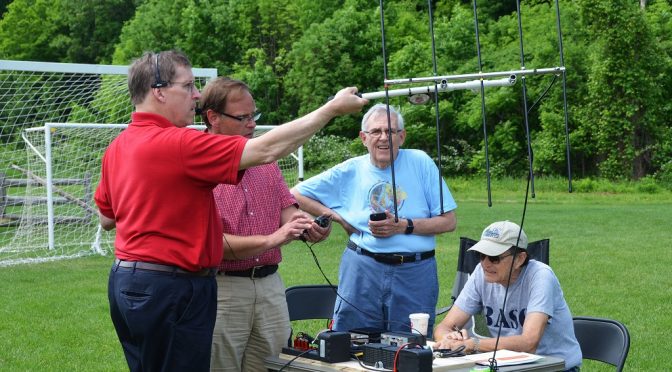.We came upon the M2 Antenna Systems booth while walking around the exhibit halls at Dayton last year. M2 had one of their LEO Pack satellite antenna systems on display there. This got us thinking about building a new, more capable version of our portable satellite station. The LEO Pack is a relatively lightweight circularly polarized antenna system for working satellites using the 2 m and 70 cm bands. It turns out that AMSAT members can purchase the LEO Pack at a discount. Starting with the LEO Pack in mind, I began to lay out some goals for a new, 2.0 Portable Satellite Station:
- Capable of working all active Amateur LEO Satellites including those using linear transponders and digital modes
- Be portable and manageable enough to be setup in an hour or less
- Simple enough to operate so that HAMs who are new to satellites can make all types of satellite contacts with a relatively short learning curve
- Utilize computer controlled antenna tracking to aim the antennas
- Utilize computer control to manage radio VFOs to compensate for Doppler shift
- Be easy to transport and store
Satellite Antena System Components

We decided to take a computer controlled approach for both antenna aiming and Transceiver VFO management. This was done to meet our goal of making the station simple to operate for new satellite operators. After some research on the available options, we choose MacDoppler from Dog Park Software Ltd. for this purpose. MacDoppler runs under Mac OS/X and works well on our MacBook Air laptop computer which is very portable.
This program also has broad support for many different rotator and transceiver platforms and is very easy to understand and use. Finally, the program features high-quality graphics which should make the station more interesting to folks with limited or no experience operating through Amateur Satellites.
With the satellite tracking software chosen, we made selections for the other major components in the 2.0 Portable Satellite Station as follows:
- Glen Martin RT-424 4.5′ Roof Tower to mount all of the antenna system components for portable operation
- M2 Antenna Systems LEO Pack Antennas and Hardware
- Yaesu G-5500 AZ/EL Rotator
- Green Heron RT-21 AZ/EL Rotator Controller
- Advanced Receiver Research Low-Noise Preamplifiers for 2m and 70 cm
- S3 Sequencers from M2 Antenna Systems for preamplifier control
- LMR-400UF Coax for feed-lines
- MacDoppler Satellite Tracking software from Dog Park Software
- Icom IC-9100 Transceiver
- WaveNode WN-2 Wattmeter
I will explain these choices in more detail as our article series proceeds.
Portable Satellite Antenna Tower

Our solution to making the antenna system portable is built around a Glen Martin 4.5′ Roof Tower. This short tower is a high-quality piece made of extruded aluminum parts. The tower is very sturdy when assembled and is light in weight. We added a pair of extended “feet” to the tower which is fabricated from 36″ x 2″ x 1 /4″ strap steel. This gives the tower a firm base to sit on and allows us to use sandbags to weight it down (more on this later).
Our chosen Yaesu G-500 AZ/EL Rotator is a relatively inexpensive Azimuth/Elevation rotator which is suitable for light-weight satellite antennas such as those in the LEO Pack. This rotator can be installed as a single unit on the top of a tower or separated using a mast. We choose the latter approach as it is mechanically more robust and helps to keep the center of gravity for our portable antenna system low for improved stability.
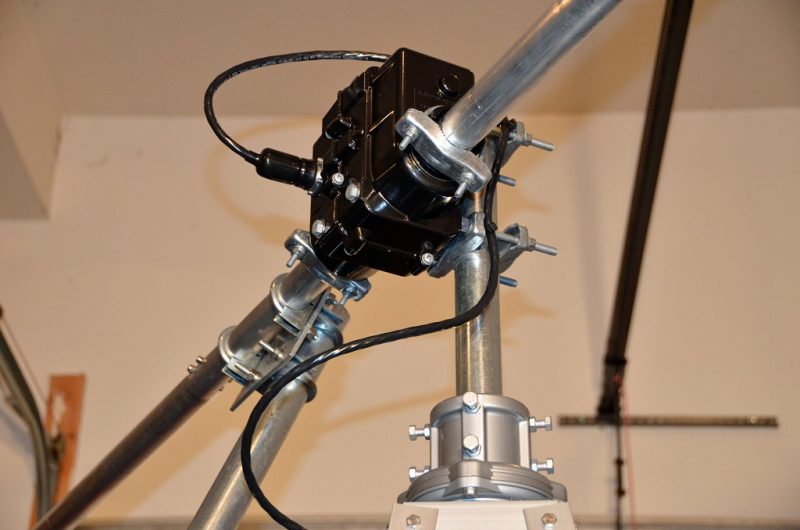
Separating the Yaesu AZ/EL rotator requires a short mast and a thrust bearing to be used. The mast was made from a 1-3/4″ O.D. piece of EMT tubing from our local hardware store. The thrust bearing is a Yaesu GS-065 unit. Both of these pieces fit nicely in the Glen Martin Tower. The thrust bearing provides support for the LEO Pack and G-500 elevation rotator and greatly reduces stress on the azimuth rotator. We also added a Yaesu GA-300 Shock Absorber Mount to the azimuth rotator. This part provides shock isolation for and reduces strain on the azimuth rotator during the frequent starts and stops which occur during satellite tracking.
Control Cables and Coax

We decided to use LMR-400 UltraFlex coax throughout our antenna system. LMR-400UF coax provides a good balance between size, flexibility, and loss for our application. To keep feed-line losses reasonable, we choose to limit the total length of the coax from the transceiver output to the antenna feed point to 50′. This results in a loss of about 1.3 dB on the 70 cm band.
The result is that our planned IC-9100 Transceiver which has a maximum output of 75W on 70 cm will deliver a little more than 50W maximum at the feed point of the 70 cm yagi. This should be more than enough power to meet our station goals. Allowing a total of 15′ for antenna rotator loops and transceiver connections, we settled upon 35′ for the length of our coax feed-lines between the tower and the station control point.

We added some custom fabricated plates to the tower to act as a bulkhead for feed line and control cable connections and to mount our low-noise preamplifiers. The control connections for the rotators and preamps were made using 6-pin weatherpack connectors and rotator control cable from DX Engineering. The control cables are also 35′ long to match the length of our coax feed lines. This length should allow the tower and the control point to be separated by a reasonable distance in portable setups.
Satellite Antenna Preamp System
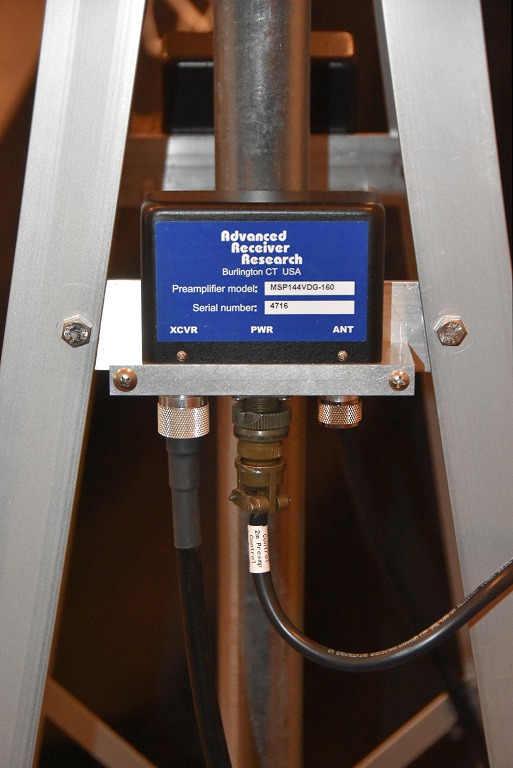
We added tower-mounted Low-Noise Preamplifiers from Advanced Receiver Research to improve the receive sensitivity and noise figure for our satellite antenna system. Two preamps are used – one each for the 2 m and one for 70 cm antennas. We decided to include the preamp control lead in our control cable to allow for control of the preamp switching via sequencers. This was done to provide an extra measure of protection for the preamps.
Miscellaneous Components
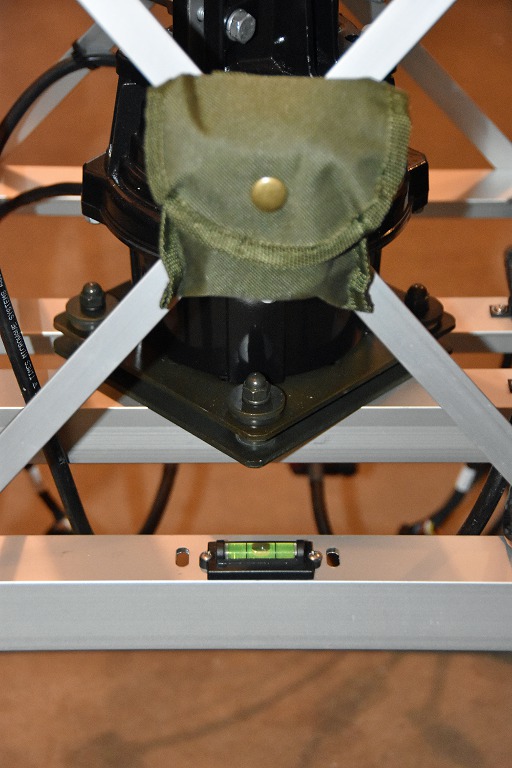
We added a compass and pair of bubble levels to the tower assembly. These additions make it easier to orient and level it during setup. This picture above also shows the Yaesu shock absorbing mount for the azimuth rotator.
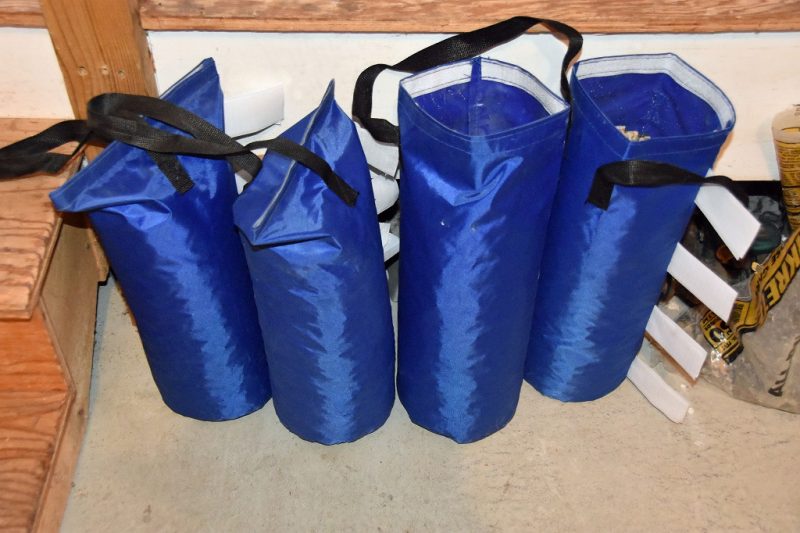
Finally, we added a set of weight bags to securely anchor the tower when it is set up in a portable environment. These bags are filled with crushed stone and fasten to the legs of the Glen Martin tower with velcro straps.
Satellite Antenna Assembly and Test
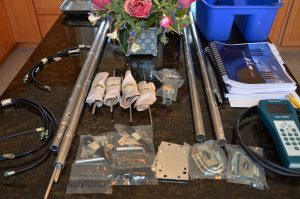
With the tower and rotator elements complete, we turned our attention to the assembly of the M2 LEO Pack. The LEO pack consists of two circularly polarized yagis for the 2m and 70 cm bands.
The 2m Yagi is an M2 Systems 2MCP8A which has 8 elements (4 horizontal and 4 vertical) and provides 9.2 dBic of gain. The 70 cm Yagi is an M2 Systems 436CP16 with 16 elements (8 horizontal and 8 vertical) and provides 13.3 dBic of gain.
Both Yagi’s are meant to be rear mounted on an 8.5′ aluminum cross boom which is included in the LEO Pack. The picture above shows all of the parts for the two antennas before assembly.
Thanks to some help from Jamey, KC1ENX and Mike, KU1V, it took us about a 1/2 day to assemble and test the antennas and both produced the specified SWR performance when assembled and test in clear surroundings.
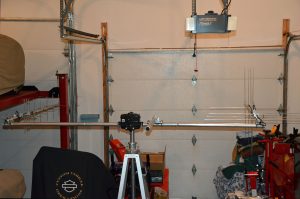
The picture above shows the assembled LEO pack on the portable tower. We attached a short 28″ piece of mast material to the cross boom as a counterweight to provide better overall balance. Also, we can minimize the strain on the elevation rotator this way. The antennas and the two outer sections of the mast can be easily removed to transport the antenna system.
Satellite Antenna Polarization
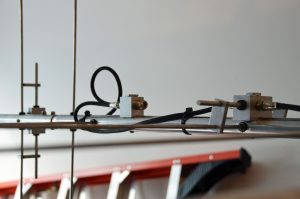
The LEO Pack yagis achieve circular polarization via a matching network. The matching network drives the vertical and horizontal sections of the antennas with a 90-degree phase shift. The phase shift (and a final 50-ohm match) is achieved using 1/4 wave delay lines made of coax cables. We configured our antennas for right-hand circular polarization.
The choice between right and left-hand circular polarization is not a critical one in our LEO satellite application. This is because most LEO satellites are not circularly polarized. The advantage of circular polarization in our application is the minimization of spin fading effects.
Satellite Antenna Rotator Controls

The final step in the construction of our antenna system was to add the rotator controller and test the computer aiming system. We have had very good results using Green Heron Engineering rotator controllers in our home station so we selected their RT-21 AZ/EL rotator controller for this application. The RT-21 AZ/EL rotator controller is really two rotator controllers in a single box. The rotator control parameters can be independently adjusted. The available settings include such as minimum and maximum rotator speed, ramp, offset, over travel, and others.
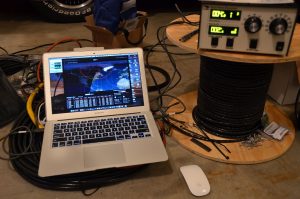
The RT-21 AZ/EL Rotator Controller connects to our computer via a pair of USB cables. We run Green Heron’s GH Tracker software on our MacBook Air laptop to manage the computer side of the rotator controller and to provide a UDP protocol interface to the MacDoppler tracking software. The picture above shows the test setup used to verify the computer controlled antenna pointing system.
Configuration and System Test
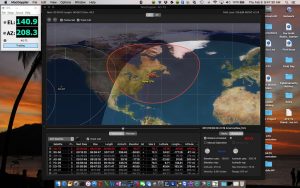
One challenge associated with selecting a Mac OS/X platform for computer control is what to do about the inevitable need to run Windows software as part of the system. In addition to the GH Tracker software, the WaveNode WN-2 Wattmeter and digital modem software for satellite/ISS APRS and other applications require a Windows run-time environment.
To solve this problem, we use a virtual machine environment implemented using VMware Fusion and Windows 10 64-bit on our MacBook Air Laptop along with Mac OS/X. Using the Unity feature of VMware Fusion allows us to run windows apps such as GH Tracker as if they were native Mac OS/X apps. The picture above shows an example of this.

With the antennas removed from the cross boom, we tested the operation of the computer controlled tracking system. The Yaesu G-5500 AZ/EL Rotator have some limits as to its pointing accuracy and backlash performance. Setting up the combination of the RT-21 AZ/EL rotator controller, GH Tracker, and MacDoppler required experimentation to achieve smooth overall operation.
We finally settled on a strategy of “lead the duck” tracking. The idea here is to set up the rotators so that they over-travel by a degree or two. Also, we couple this with a relatively wide 2-3 degree tracking resolution. This maximizes the overall accuracy of the pointing system. Also, we minimize the tendency towards the constant start-stop operation of the rotators during satellite tracking. Our current configuration for all of the elements involved in the tracking system is shown above.
Next Steps
We can now move onto the next step in our project – the construction of a computer controlled transceiver system. We will cover this element in the next part in this series. Other articles in the series include:
- A Simple Station for AO-85 (Part 1)
- 2.0 Station Radio and Supporting Equipment (Part 3)
- 2.0 Station First Contacts! (Part 4)
You may also be interested in the satellite station at our home QTH. You can read more about that here.
Fred, AB1OC


